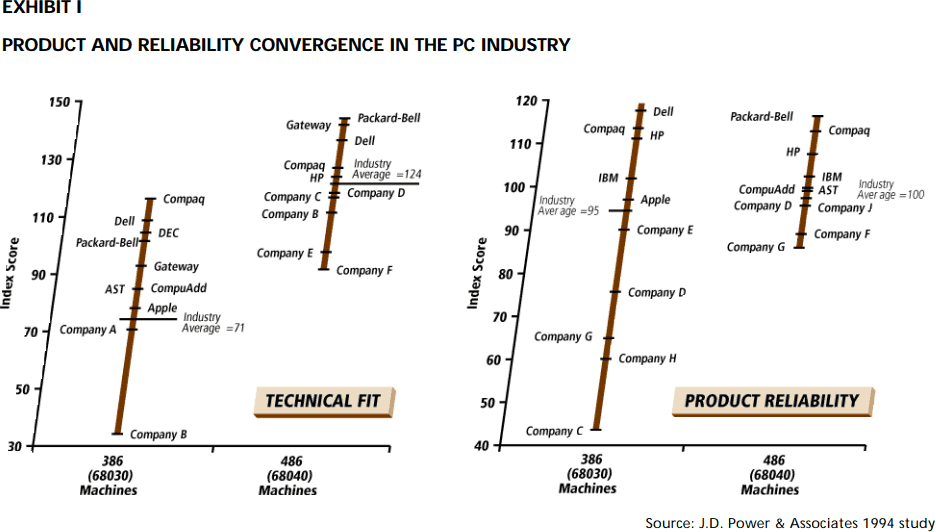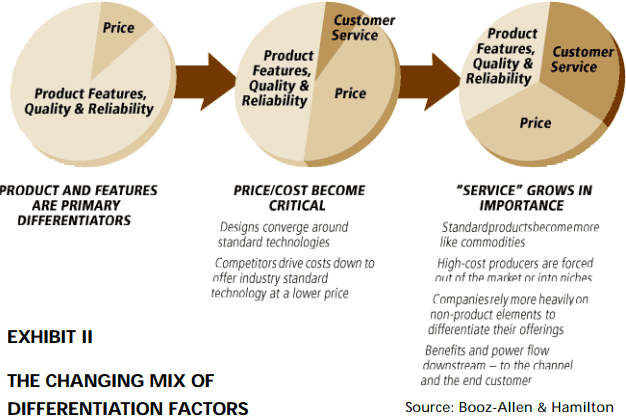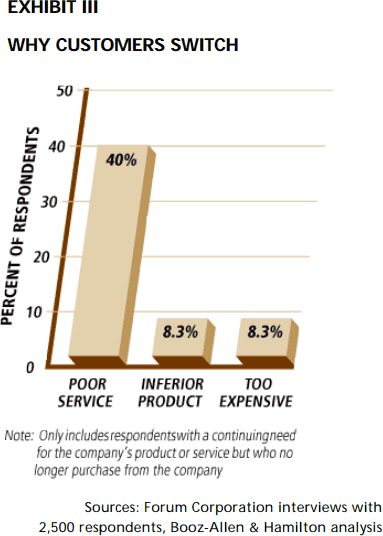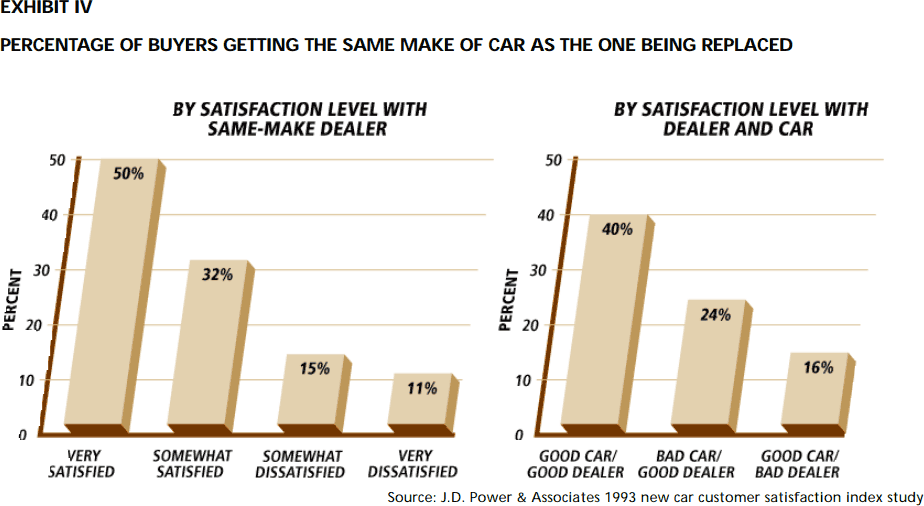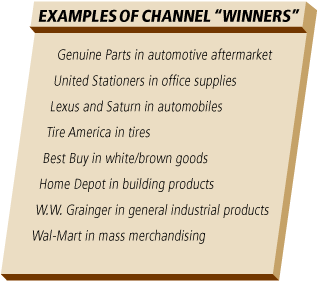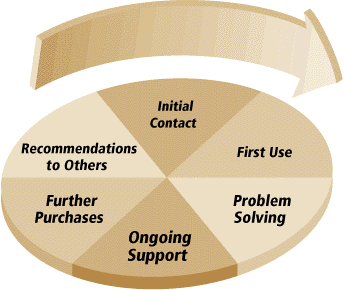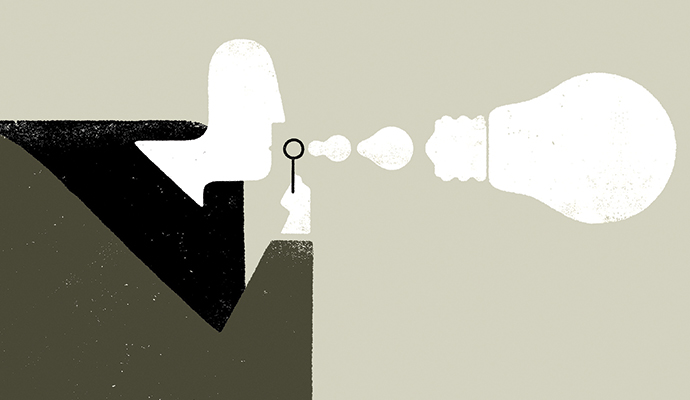How to Treat Customers Right: Winning the Channels Challenge
Suppliers of goods and services that flow through distribution channels face unique challenges. A 10-point plan shows the way to deliver the proper price and service to those who really count: the end users.
“It is astonishing to observe the number of companies embroiled in vigorous, long-standing internal debates about who their customer is - the channel or the end user,” writes author Evan Hirsh of Booz-Allen & Hamilton which has been actively exploring customer care and distribution channel issues. Supplier/channel relationships are inherently adversarial, he points out, as each side attempts to capture a larger share of the value they together create. The challenge for many companies is that channels have become the basic determinants of performance improvement and growth. So they must learn how to deal with channels or lose ground.
Using examples from Daewoo, General Electric, Saturn, Sherwin-Williams and Wilsonart, Hirsh produces a set of 10 guidelines to help suppliers overcome the channels challenge. The underlying lessons to be drawn are that the customer should come first and the channel second (there is no choice in this matter), and that the conflict between supplier and channel may very well intensify rather than diminish with time. Daewoo’s entry into the British automobile market is cited as a good example of how channel friction, in this case affecting a conventional franchise dealer network, can even go so far as to open the gate to new participants.
An essential element that all successful channel programs have in common, Hirsh notes, is the use of measurements. One of the main reasons Wilsonart leapfrogged ahead of Formica in the industry segment that Formica gave its name to, he says, is the company’s exceptionally advanced channel management system. Distributor expectations and performance are quantified relentlessly, capped by a three-day evaluation at an annual channel planning exercise. The message here, in the face of an increasingly demanding consumer, is that effective channel management is critical to customer care and improved corporate performance.
The proper care and feeding of customers is a hot topic these days. Whether the discussion goes under the name customer satisfaction, zero defections, loyalty or intimacy, the customer issue has pushed its way to the top of the agenda for a growing number of C.E.O.'s.Yet despite all that attention, surprisingly little is said about a core problem many a chief executive faces: how do I insure that my end customers receive the right service at the right price? Indeed, although at least half of all goods and a significant portion of services flow through distribution channels, most of the extensive body of writing about customer care either addresses services provided directly to customers -- by airlines, banks, hotels -- or simply skirts the complication of dealing through intermediaries.
This article addresses head-on the unique challenges faced by suppliers of goods and services that flow through distribution channels.
The article begins by briefly describing the underlying dynamics of the "channels challenge" and its increasing importance to most companies. It then discusses 10 principles for winning the challenge.
 The principles have been developed by Booz-Allen & Hamilton, which has been actively exploring customer care and channel issues. Our insights are based on a combination of client work across a broad range of industries and on in-depth case studies of specific company successes and failures outside of our client work. (See "How Novell Manages Its Reseller Channel," Issue 3 of Strategy & Business.) The distillation of this extensive effort has yielded a useful set of guidelines for dealing with channels. As is typical, the lessons learned from the companies struggling to become successful or to regain lost ground are at least as revealing as those synthesized from the winners.
The principles have been developed by Booz-Allen & Hamilton, which has been actively exploring customer care and channel issues. Our insights are based on a combination of client work across a broad range of industries and on in-depth case studies of specific company successes and failures outside of our client work. (See "How Novell Manages Its Reseller Channel," Issue 3 of Strategy & Business.) The distillation of this extensive effort has yielded a useful set of guidelines for dealing with channels. As is typical, the lessons learned from the companies struggling to become successful or to regain lost ground are at least as revealing as those synthesized from the winners.
Given the importance of channels in customer care, why has this topic not received more attention? Obviously, the examples and the rationale are far more straightforward in situations involving a single product and a direct customer interface, e.g., consumer credit cards. But more importantly, supplier/channel relationships are inherently adversarial and complex -- and therefore less susceptible to facile analysis. There is an underlying power struggle as each side attempts to capture a larger share of the value they together create. In essence, to gain more power, the supplier strives to commoditize the channel's value-added while the channel strives to commoditize the supplier's product.
Moreover, the supplier/channel balance of power is constantly shifting as the economics of serving end customers changes over time. Suppliers who are dealing with their channels the same way they were five years ago are invariably behind or disadvantaged.
Distribution channels basically provide three functions: information flow (outward information about the supplier's offering and inward flow about customers' needs), logistics to get the supplier's product to the end customer, and value-added services that augment the supplier's product (local selling, financing, customization, after-sales parts and service, etc.). When improved alternatives for providing these functions evolve or when customer expectations rise, the failure of existing channels to respond prevents the supplier from adequately satisfying the customer.
For instance, some dealers, distributors and suppliers are capitalizing on the Internet as an expeditious and efficient means to exchange information with customers. Also, new logistics networks such as cross-docking systems are allowing some suppliers to deliver goods faster and with lower cost. Consequently, the channel's role and economics are altered. However, existing channel members are often loath to adjust.
But why, now more than ever, are suppliers finding that the basic determinants of performance improvement and growth lie beyond the factory gate -- in the channels? There are five reasons.
The first is the greater availability of goods that are close substitutes for each other in the customers' eyes. Substantial, sustainable differentiation in terms of basic product values that the supplier directly controls -- such as functionality, quality or even styling -- is harder to come by.
J.D. Power & Associates' study of the personal computer industry offers a vivid illustration of the rapid diminishment of product-based differentiation. (See Exhibit I.) From one product generation to the next, customers' perceptions of the industry's range of performance in the two primary, product-based drivers of satisfaction shrank sharply. At the same time, the industry's average satisfaction level was increasing on both dimensions. The reduction of product-based differentiation is typical of maturing markets and is common across industries. (See Exhibits II and III.)
Thus, it is the channel that increasingly drives differentiation in competitors' offerings, customer satisfaction and, consequently, loyalty. J. D. Power's research provides a remarkable representation of this point in the American automobile industry, where models have proliferated and perceived product quality within segments is closing on parity. In this situation, the impact of the distribution channel on customer satisfaction and loyalty is tremendous. (See Exhibit IV.)
The second reason: increasing customer choice and customer segment fragmentation contribute to the heightened importance of channels in customer care. The proliferation of high-quality goods and services allows suppliers to capitalize on smaller differences in customers' needs and wants. Since a larger portion of the differentiation is service-related, suppliers must insure that the channels bundle the right types and variety of service elements with their products to satisfy the full range of potential customers.
Third, as product-based differentiation declines, the traditional sources of suppliers' power over the channels -- superior product, brand pull or large installed base -- are weakened. Channel players that recognize and capitalize on the evolving service needs of customers and/or develop advantaged economics quickly gain ground. Examples of large, strong channel "winners" abound. (See Exhibit V.) Many suppliers are now grappling with ways to handle the powerful intermediaries that have arisen. That is not necessarily a bad thing: in some cases, it means trying to figure out how to take advantage of new opportunities created by the channel.
EXHIBIT V
Source: Booz-Allen & HamiltonFourth, re-engineering efforts have typically been aimed initially at internal operating and administrative processes and then at external suppliers -- work on downstream activities, particularly in the channels, has been limited and more recent. Nonetheless, those activities account for a major portion of what the customer pays. As suppliers exhaust the rewards of internal and vendor re-engineering programs, they naturally seek the fertile territory downstream.
Fifth, as in many other business trends, technology, and information technology in particular, is the key enabler. Advances in technology are helping to drive the shifts in the economics of channel functions. These advances are providing better means to capture and utilize information about customer needs and behaviors. They also offer new ways to manage the physical flow of goods, such as vendor-managed inventories, resulting in greater availability at less cost. And, through electronic methods, they lower the cost and improve the functionality of supplier/channel interactions, such as ordering, invoicing and payments. In general, better, readily available and cheaper information yields more sophisticated and more demanding channel players and customers.
Thus, the inherent conflict between suppliers and their channels, combined with the transient nature of the underlying economics of the relationship, constitute the often-neglected channels challenge. And, for the reasons noted, that challenge is increasingly confronting suppliers as they seek to grow and improve performance.
Principles of Successful Customer Care Through Channels
When faced with the channels challenge, many suppliers have found ways to thrive. Those who failed to respond, or faltered in their attempts to do so, have lost ground to competitors or have suffered as strong channel players emerged. The 10 principles that follow offer do's and don'ts that can help determine which side of the ledger a supplier winds up on.
1. Increase the value customers receive.
Most important of all, customer care through channels is about tangible value, not attitude or superficial changes. It's about the customer primarily and about the channel secondarily. It's about the value that customers recognize, not on how much is created and transferred to the channel.
Improved value for the customer comes from lower costs or better service. It is substantive and measurable, and it results in greater price realization, higher margins and/or increased volume. Despite what much of the literature on customer service suggests, customer care is not primarily about mind-set, culture change or being nice.
Only by first establishing how to optimize value for the customer can a supplier determine the channel's share. Nonetheless, the typical interaction focuses on the supplier's desires versus the channel's desires. It is astonishing to observe the number of companies embroiled in vigorous, longstanding internal debates about who their customer is -- the channel or the end user. But once the customer relationship is relinquished to the channel, in an act of appeasement by the supplier, it is hard to reclaim.
Most suppliers are now recognizing that to fall into this trap is neither in their interests nor the interests of the end customer. And they are coming to understand that customer value can only be maximized when the supplier/channel business system is optimized as a whole, not piecemeal, and that the focus, first and foremost, must be on the customer's needs and desires.
2. Concentrate on the few factors that matter.
Successful companies identify and target the few dimensions of service that customers really value and pay for.
By contrast, companies that are unsuccessful have spent money too broadly in a scattershot approach to improving service. Often, they have essentially bribed their channel to provide better service. However, as with most service improvement programs, the results tend to be disappointing since the underlying drivers of customer value are not affected. Good performers in the channel end up getting paid for what they are already doing, and poor performers only undertake short-lived, superficial steps to make their customers happy. The channel as a whole is unlikely to make fundamental changes without concerted, focused assistance.
For example, one luxury car manufacturer discovered that its program to motivate dealers to improve service with financial incentives had little substantive impact. The manufacturer found that what distinguished the better dealers was their higher performance in the more difficult areas of customer satisfaction. These included fixing a car right the first time, the availability of parts and the quality of the service work performed. The manufacturer's financial inducements had virtually no effect on these drivers of satisfaction. The better dealers were already striving in these areas, and those performing poorly had neither the instincts nor the capabilities to alter their behavior. Instead, this latter group, when prompted, was inclined to focus on factors that had less leverage with customers. In other words, having a pleasant service adviser cannot compensate for a car that is not fixed right the first time.
Another common view of customer service campaigns is that the customer may end up happier but only at additional cost to the extended enterprise, and mostly to the supplier. Increased satisfaction is assumed to require increased service, which is presumed to cost more. This may be true of the broad, superficial efforts. However, customer care programs focused on a few key drivers of value for selected segments of the market usually result in major efficiency gains. And those gains can offset any additional costs.
In order to target critical elements that can create true value, customer care programs must consider the economics of serving customers. This understanding is used to identify redundant or low-value activities and to flag opportunities that have attractive returns. Thus, well-directed programs should lead to lower costs and/or higher revenues or margins.
3. Own the service brand, not just the product brand.
Channel customer care can and should build brand value based on distinguished, consistent channel service and support. Beyond the more tangible customer benefits of lower cost and better service, suppliers should also seek to create value by building strong brands around the service provided through the channel.
Ceding ownership of the customer relationship to the channel is commonly a key component of brand erosion. Thus, to retain and enhance brand value, suppliers must insure that the desired service elements are provided adequately and consistently and that the marketing mix reinforces the service image.
The Saturn automobile is a prime example of the shift in emphasis away from product-based brand value. Saturn's brand development is focused on the buying experience, service and support. It is notable that the three car brands in the United States with the highest customer satisfaction (Lexus, Infiniti and Saturn), according to research by J.D. Power, all have de novo dealer networks designed, developed and managed with an intense pursuit of consistent, exceptional customer service.
4. Customize your customer care.
The most rewarding channel customer care programs attack the issues at the level of specific customer segments. The creation of value reflects how service needs vary among customers.
To improve the value, channel customer care depends on accurate and sufficiently precise understanding of customers' needs and the economics of serving those needs. However, as noted, most suppliers tend to focus on the needs of the channel, and not the actual customer. Their views of customers are limited in breadth and depth, often filtered by the channel and not necessarily current. The market research they do perform usually involves product-based, supplier-driven issues such as preferred product type and features.
Instead, customer care improvement requires knowledge of service-based, channel-driven needs. This understanding must typically be built from scratch. Facts and data are usually required to supplement or counter existing biases and intuition, and understanding the customer's underlying economic dynamics is crucial. It is also essential to objectively assess the inevitable investment costs versus the benefits. The insights about customer service requirements must clearly uncover specific variations across non-homogeneous groupings. The purpose of segmentation in this context is to identify sets of customers whose key drivers of value differ, so that solutions can be designed accordingly.
Consider the customized customer care program used by the General Electric Company's electrical distribution products unit. One portion of this business makes circuit breakers and panel boards for new or retrofitted commercial and industrial buildings. Contractors purchase the products from electrical distributors. They also receive a variety of services directly from the manufacturer, depending on the size and type of job, since the products are often specified, priced and built for a particular job.
The economics of the contractors' business are such that delays in receiving materials at the job site are extremely costly. People and equipment costs, possible completion deadline penalties and subsequent delays for other contractors affect the economic equation. So the No. 1 need of all contractors is on-time delivery.
However, the secondary need varies by type of contractor or type of job. For many small projects, "quote responsiveness" is the No. 2 requirement. Unlike large jobs that have a long, complex bidding and quoting process, small jobs tend to have a short fuse and can be won or lost based on the contractor's ability to quote quickly.
G.E. recognized this distinction and developed an easy-to-use, PC-based quoting system for small jobs that the distributor can utilize instead of having the manufacturer involved, as in the process for large jobs. Consequently, G.E.'s quote time is recognized as faster than that of its three major competitors, a distinction that has given G.E. a significantly greater share in this targeted and higher-margin portion of the market.
It is revealing to build an understanding of customer needs in the context of what Jan Carlson, former head of S.A.S., the airline, called "moments of truth" -- the sequence of critical transactions across each stage of the ownership or use cycle. (See Exhibit VI.) Evaluating the degree to which satisfaction and value are affected at these different points in the cycle, and how they vary by customer type, can be the key to understanding customer behavior.
EXHIBIT VI
Moments of Truth
Source: Booz-Allen & HamiltonAn interesting example of a "moments of truth" analysis is in the cellular phone service industry, where most consumers have only one interaction with a channel, at the time of the original sale. In the United States, high satisfaction with this initial sales experience turns out to be critically important. It translates into a longer association with the service provider, which is the No. 1 determinant of customer profitability. The satisfaction level is based on how well the sales channel explains features and service charges and sets the proper expectations for the consumer.
One other "moments of truth" example also illustrates the relevance of differences across customer segments. A car manufacturer found that an important source of customer dissatisfaction with the buying process could be overcome by having dealer sales personnel carefully explain operating and instrument display functions. Unfortunately, the manufacturer failed to realize that while some customers were indeed pleased with this service, others were put off by having to sit through a mandated demonstration session that they viewed as bothersome and perfunctory.
5. Unbundle your channel(s).
 Not only should the understanding of the market be segment specific, it should also be service element specific. Effective channel customer care relies upon a full knowledge of how to optimize the mix and level of individual channel functions provided to the various customers.
Not only should the understanding of the market be segment specific, it should also be service element specific. Effective channel customer care relies upon a full knowledge of how to optimize the mix and level of individual channel functions provided to the various customers.
Traditionally, channels have been considered monolithic entities, with inherent sets of bundled functions. With this view, channel functions could not be feasibly separated, and a channel's functions and economics could not be altered. Suppliers dealt with channel issues only as decisions about which channels to sell through.
Instead, the customer and channel understanding must enlighten the supplier about how to provide the right mix and levels of channel functions to distinct customer segments, and in the most economic manner. Suppliers must manage channels at the level of unbundled functions. That means utilizing differing formats within the same channels and alternate channels, to deliver the desired service and product bundles to the target customer segments.
For instance, the American auto industry is facing a barrage of new channel formats that fulfill various elements of the traditional dealer role: the Internet for information exchange or actual sales transactions, buying clubs that act as sales intermediaries and online purveyors of financing options, not to mention auto malls and mega-dealers of used cars. More than ever before, the manufacturers and their dealers are being pressed to evaluate how best to serve different customers' needs. To do that, they must understand those needs in terms of unbundled functions (e.g., local marketing, new car sales, financing, used-car trade-in and sales, parts supply and service) and appreciate the linkages across functions for different customers and for the alternative channel formats.
6. Win in multiple channels.
With the increasing fragmentation of end markets, most suppliers are finding that it is more and more difficult to use just one channel to access their total potential market and to grow. Thus, they must confront the challenge of managing the conflicts across multiple channels in order to maximize customer reach and satisfaction.
These conflicts have two root causes. One is pricing and incentive differences. The other is competition for the same customers.
The pricing issues must be viewed comprehensively to prevent arbitrage across channels and across levels in the distribution hierarchy, to keep one channel from dominating other important channels and to insure that required value-added services can be supported by the appropriate channels. Some level of competition for customers among channels may be desired, but any damaging overlap should be identified in the planning stage.
The arsenal that suppliers can draw upon to manage these potential conflicts and to serve the various needs of different customers and different channels is extensive -- brand differences, product differences, supplier-provided service differences, incentive and pricing policy, upfront allocation of customer types, supply policy or order size differences. Adroitly designing and deploying the appropriate mix of tactics to achieve a desired end game is crucial to protecting existing markets and to securing new ones.
Sherwin-Williams provides a fine example of winning in multiple channels and of managing cross-channel conflict. Its paint flows through several different channels -- mass merchants, home centers, independent paint stores and Sherwin-Williams paint stores. The product itself is similar, if not exactly the same; however, to serve a wide variety of customers, the brand name, the price and the accompanying services and support all vary across channels and sometimes within a channel.
7. Build a vision.
As already noted, channel issues are usually complex. Typically, numerous customer segments are involved, as are multiple channels performing several functions. Although channels should be dissected and assessed at the individual function level, they are also systems with interconnected paths and linkages, and these must also be analyzed and understood.
Finally, the solution usually requires a substantial internal and external transition program. Thus, suppliers should build a well-considered plan for the end game before embarking on any program for change. Channel customer care programs work best when based on a fully reasoned, holistic vision.
One large capital goods manufacturer set out on a path to rationalize its dealer network. The idea was to reduce the number of facilities, change the locations and improve physical formats. This extremely expensive program was beneficial. However, the results were much less impressive than they should have been. Lacking a broader vision of the drivers of customer satisfaction, the program failed to address other critical elements, including more competent repair operations and better availability of parts.
Channel networks are not only interconnected; they are multifunctional in nature. So they need to be addressed accordingly. Delegating customer care improvement to a customer service function is a sure sign that the results will be disappointing. In fact, delegating responsibility down into any functional organization without significant senior management attention and forethought seldom works well. The relevant business processes invariably involve several functional areas. Sales, marketing, operations and financial interests need to be considered. Strategic, operational and information system skills are required. Fundamental value enhancement thus requires coherency across functions, across internal and external organizational boundaries and across decision-time horizons.
8. Expect conflict and be prepared to deal with it.
The conflict inherent in all this is broader than the cross-channel tensions discussed above. It stems from the supplier recognizing that the existing channels are not performing satisfactorily and then trying to drive change in those channels or finding new channels. Often some of the existing channel members are unwilling and/or unable to make the necessary transition. And contrary to conventional wisdom, the answer is not always a partnership approach.
The extent of the conflict is largely determined by how much the underlying economics have shifted. The shift over time in economics corresponds to a supplier/channel relationship life cycle, which is somewhat analogous to a product life cycle. In the first stage, the interests of the two parties appear aligned as they rapidly grow the business. In this stage, conflict seldom exists, and there is little need for adjusting the channel's behavior.
In the second stage, the need arises either to extract broad efficiency gains from the supplier/channel business system or to target customer satisfaction improvements, including efficiency, for specific customer segments or channels.
In the third and final stage, either because the underlying economics have shifted so significantly or because the business is shrinking, the interests of the two parties are no longer aligned. Conflict can be intense and rampant. The supplier seeks to fundamentally redesign ways to serve the customer. Often entirely new business systems must be established.
Indeed, the third stage often provides an ideal opportunity for a new participant in the market. Daewoo's entry into the British car market offers a good example. Daewoo created a radical channel approach to meet fundamental customer needs not satisfied effectively by the existing channel. It started the process with an extensive market research campaign about what customers wanted from a new car company. The campaign was conducted with a toll-free telephone number and a promotion for 200 free one-year test drives. The result was a database on 200,000 target customers.
Daewoo found, consistent with the J.D. Power research in the United States, that customers were not happy with the current system. In particular, they disliked how they were treated when buying a car; they also didn't like the after-sales service they received. Daewoo recognized the inherent dealer/manufacturer conflicts of interest and realized that a conventional franchise dealer network would not achieve the desired results. Alternatively, comprehending the differing economics for the various channel functions, it built a three-tier channel:
* 30 flagship, wholly owned new car sales outlets, which do not provide service or sell used cars
* 100 secondary, wholly owned sites, which sell new cars, perform service and also sell used cars
* 136 tertiary service sites, which are located at an independent chain of parts and service facilities, Halfords, but are staffed by Daewoo personnel.
Daewoo's customer understanding helped it to design every element of the sales and ownership experience, to maximize satisfaction and to provide a consistent brand image. The company consciously sought to establish and maintain direct relationships with customers, without any confusion about who should drive satisfaction and loyalty -- the channel or the manufacturer. Daewoo's approach has resulted in unprecedented success for a new entrant, in terms of brand recognition, consumer consideration of the product and actual market share.
9. Execute, execute, execute.
As in most major programs, a myriad of potential execution problems can cripple the effort. The case of one automotive after-market parts supplier exemplifies this point.
The supplier had a very sound strategy, but failed to make any progress when the channel balked at the program. The supplier realized that its customers would be better served if prices more directly reflected the costs in the channel. Traditionally, the higher costs of handling low-volume, slow-moving parts were subsidized by high-volume product prices. As a result, inefficient logistics systems that did not differentiate between types of products were encouraged, and customers ended up paying more overall than they should have. Despite having a valid concept, this supplier failed -- by not having a thorough execution plan that could address resistance in the channel. When the first set of distributors objected, the manufacturer retreated, and all hope for pushing the program forward was lost.
Meaningful value creation demands that improvements in efficiency and effectiveness must be driven through the channel to the customer. The potential implications of such change are great. They include: restructuring supplier/channel alignments, altering the supplier's and channel's value-added roles, rethinking customer interfaces, redesigning service offerings, re-engineering processes and transforming information and technology usage. Along the way, people's jobs are recast and sometimes eliminated. This type of change obviously demands substantial resources, time and effort. Companies used to making investments in internal product development have to adjust to making investments in external service development. The people issues -- internal as well as external -- can be particularly difficult to handle.
The aforementioned examples -- G.E., Sherwin-Williams, Daewoo, Saturn and others -- show just how much work it takes to have a successful customer-care program. But one essential execution element all successful programs have in common is the use of measurements.
Suppliers need measurements to make the necessary commitment, to track the results, to motivate the channel and to help navigate the change program. The benefits need to be quantifiable. They should be quantified at the operating level and also tied to financial performance (e.g., a 5-day improvement in quote responsiveness translates into a 3-point share increase, which results in a $50 million revenue increase and a $15 million margin increase). The improvement must also be quantified and communicated to the channels to help sell the program. The results should be monitored routinely, at both the operational and bottom-line levels.
Wilsonart offers an enlightening example of the use of measurements and the type of detail required for effective channel management. The Formica Corporation popularized decorative laminates, which became synonymous with the company's name, and it dominated the industry from its inception in 1913 until the 1970's. However, Formica today is a distant second to Wilsonart in the $1.5 billion United States market.
One of the reasons is that Wilsonart has built exceptionally advanced distributor management processes. The company relentlessly focuses on quantifiable drivers of distributor performance -- which in turn help drive customer satisfaction.
Wilsonart explicitly defines its expectations of the distributors. Company personnel are trained to address these performance areas whenever contacting distributors. Some examples of these performance measures and typical minimum objectives for each distributor are: 1) 45 percent market share, 2) 26 percent gross margin, 3) 8-10 inventory turns per week, 4) three deliveries per week to each customer, and 5) greater than 98 percent order completion.
Distributors are involved in a thorough annual planning exercise to develop mutually agreed performance commitments and to coordinate channel activities such as promotions. During this process, distributors are carefully evaluated in a three-day review. Wilsonart may even commission outside research to independently and objectively evaluate hard-to-determine measures, such as distributors' market shares in each of several, well-defined customer segments.
10. Don't stop.
Channel customer care requires a serious commitment of time. The supplier can seldom mandate change on its terms; instead the channel must be persuaded to change. This is usually a fairly laborious process because many channel members distrust their suppliers. They are commonly conservative and resistant to change, even for compelling reasons. In addition, many channels are composed of a large number of individual entities, making the required individualized communication difficult. Besides the external tasks, the required internal process, systems and people changes also typically take substantial time.
Furthermore, successful customer care efforts do not have a definitive end date. They are forward looking and include some form of institutional learning. Customer needs advance because of better information and improved offerings from competitors or from other industries. Often the skills developed for one market segment have some applicability in others. Attempts to raise customer understanding levels typically highlight the benefits of such information, which then leads to further efforts to evaluate customer needs and trends. Successful programs tend to justify incremental investments -- and structure their efforts to use market feedback to redesign, update and expand customer care on an ongoing basis. Particularly when channels are involved, companies need to create economically viable mechanisms to have a two-way dialogue with customers on an ongoing basis.
For example, at G.E., the company uses its customer service hotline to provide insight into customer needs. Similarly, Intuit, the leading home financial management software maker, is leveraging its hotline. When customers call, asking for assistance on problems that the software does not readily address, rather than expeditiously dismiss the caller, the service representative carefully identifies the customer's need and records it in a database to help in the development of software updates and products.
Also, a key component of Daewoo's approach to the British automobile market is a continuing dialogue between the manufacturer and its customers. Building on the customer database it developed for initial market research, information is updated about customers through several direct conversations during the ownership cycle. For instance, when a mechanic services a car, he talks to the customer and records useful feedback, and more information is collected when followup phone calls are made to check that the work was satisfactory. In addition, Daewoo regularly talks to the 200 people who received the free one-year test drives. Daewoo uses these direct methods in place of the conventional customer satisfaction surveys.
Managing the Dislocations
Suppliers are facing a large number of dislocating changes: everything from fragmenting customer segments to swiftly advancing information technology to a raft of challenges from new "power" channels. The common denominator is that reactions to those changes, in the form of cost and effectiveness improvements, must occur downstream if margins are to get bigger and growth is to accelerate.
As the basis of competition then shifts from product to service, and as traditional sources of power over distribution channels decline, new strategies and capabilities are needed to meet escalating customer demands.
Suppliers should respond not with superficial service programs, but by developing ways to deliver greater value to end customers. ![]()
Reprint No. 96303


